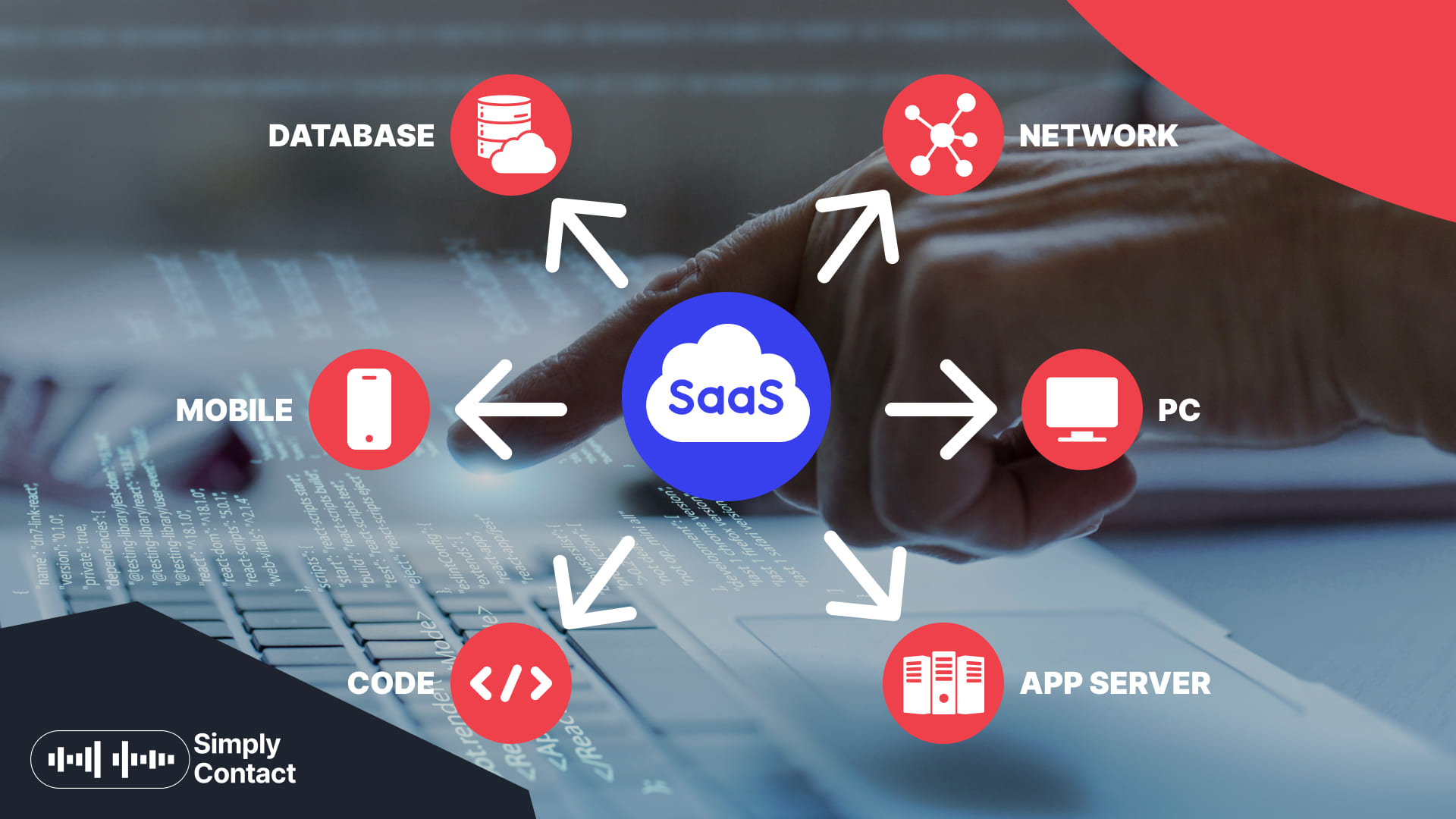At Simply Contact, we specialize in creating personalized customer support solutions that drive business growth and customer satisfaction. Let us help you elevate your customer experience and stand out from the competition.

How To Structure Your SaaS Support Team: Expert Strategies for Success
Providing reliable SaaS support is essential for any top-rated Software-as-a-Service (SaaS) business. However, building a team that delivers exceptional support requires more than simply hiring agents and putting them on the phone. It involves a thoughtful SaaS support strategy to create a SaaS team that understands your business and your customers' unique needs and challenges.
By implementing our expertise, you can enhance customer retention, reduce churn, and increase customer lifetime value, ultimately leading to higher revenue and sustainable growth. So, let's get started and explore effective strategies for structuring your SaaS support team.

Structuring your SaaS support team for success
Team efficiency begins with proper support team structure. By dividing the support workload into manageable chunks, you create dedicated spaces for addressing various client needs, resulting in quicker and more effective solutions.
Structuring by product/solution offered
To structure your team effectively, it is important to consider the products or services offered by your company.
By assigning agents with particular product knowledge and responsibilities to each product or service, you develop a team of expert representatives with the skills to sharp-shoot any issue that comes up in that specific area in the shortest terms. This approach allows agents to efficiently handle product-related problems rather than dealing with issues across your entire product line, leading to faster resolution times.
By structuring your team this way, you can also ensure that your customers receive more attentive and efficient service. Customers will work with specifically trained agents to handle their needs rather than dealing with generalist representatives who may not be as knowledgeable about a particular product.
Structuring by region/time-zone
Another effective way to provide personalized customer service is structuring your customer service team by region or time zone. Operating in multiple time zones or countries and having region/time-zone-specific staff members who can become more familiar with the needs and preferences of their respective customers enables the support team to respond to inquiries more effectively, leading to increased customer satisfaction.
Needless to say structuring your team in this way helps ensure that your customers receive support during local business hours. This strategy can be especially important for companies with customers in different time zones, where traditional business hours may not be feasible.
Tiering support system for SaaS companies
Delivering outstanding customer SaaS support software to clients at varying levels of product use is vital for the success of any Software-as-a-Service (SaaS) business. One effective approach to achieving top-rated customer service is by implementing a tiered support system. This structure answers why customer support is vital for a SaaS company? Treating all customers equally and making them feel valued is essential.
Treating all customers equally and making them feel valued is essential. This can be accomplished by assigning dedicated support teams to different customer segments based on factors such as customer base size and product/service complexity. Here are a few examples of customer support tiers.
Freemium customers
Providing assistance that motivates freemium customers to upgrade their service is essential. This can be achieved by offering enticing benefits, such as access to premium features, exclusive discounts, and promotions, highlighting the added value of upgrading. By showcasing the advantages of the paid version, freemium customers can be encouraged to make the transition and unlock a higher level of service.
Paid customers
The support team should focus on customer retention and ensuring satisfaction regarding paid customers. Offering prioritized support to paid customers, including quick response times and prompt issue resolution, is crucial in building trust and maintaining a positive customer experience.
Enterprise customers
Enterprise customers refer to B2B clients with larger accounts and more intricate requirements. When serving these customers, the support team should prioritize managing their accounts and offering personalized solutions to address their specific issues. This may involve implementing dedicated account managers, providing customized handbooks, and ensuring 24/7 support.
Certainly, implementing a tiered support system can help SaaS companies provide top-rated customer service to all their customers. Companies can improve customer satisfaction and retention by treating customers equally and tailoring support to specific customer segments.

How to build the SaaS support team
In the early stages of your business, it is common for your SaaS support team to be small, with individuals handling multiple roles and responsibilities. However, as your customer base expands and your product becomes more complex, it becomes crucial to scale and specialize your support team. When structuring your SaaS support team, there are several steps you can take to ensure its effectiveness.
Now, let's delve into these steps and examine them in detail.
Determining team composition
The size and composition of your SaaS support team depend on numerous factors, such as customer base, product complexity, and support volume. Some companies prefer generalists who can handle various support inquiries; others prefer specialists focusing on specific support areas, such as technical issues or billing inquiries.
Finding the right team composition that aligns with your company's needs is essential for maximizing support efficiency. Factors such as customer base and reach, product complexity, and time zones or regions must be considered. Avoiding overstaffing or understaffing is vital, as they can lead to inefficiencies in your support operations. By striking the right balance, you can effectively ensure optimal support quality and responsiveness to meet your customers' needs.
Identifying communication channels
Effective communication is vital for a successful SaaS support team. You'll need to determine your team's most functional communication channels, such as help desk software, chat tools, and video conferencing.
Employ proper communication channels based on your team size and customer needs. For example, a small team can benefit from a simple chat tool, while a larger group may require more advanced help desk software.
An omnichannel approach in SaaS support provides a consistent experience across all channels. Agents may focus on specific channels but should be connected for seamless information sharing. This approach enables collaboration and helps resolve customer inquiries regardless of their channel.
Implementing training and development programs
Training and development initiatives are crucial in building a successful SaaS support team. It is imperative that your support team members are well-trained in your product and equipped with exceptional soft skills, such as empathy, effective communication, and problem-solving abilities.
Establishing key performance indicators (KPIs) and metrics
Utilizing KPIs and metrics can significantly enhance your support team's performance. You can set targets and monitor progress effectively by measuring important factors like customer satisfaction score, first response time, resolution time, and ticket volume. This enables you to identify areas for improvement and ensure your support team consistently meets your customers' needs.
Implementing self-service resources
In today's fast-paced world, customers expect quick and easily accessible information, which also holds true for SaaS companies. By providing effective self-service resources, you empower your customers to find answers to their questions independently, reducing the burden on support teams and enhancing overall customer satisfaction.
Self-service resources such as knowledge base blogs, FAQs, and video tutorials are essential for any SaaS company. They offer customers 24/7 access to the information they need, reducing the need to contact the support team and ultimately lowering support costs.
Monitoring and analyzing customer feedback
The success of a SaaS heavily depends on its ability to provide excellent customer support. One significant way to ensure that your support team delivers the best service possible is to monitor and analyze customer feedback. By gathering and evaluating customer feedback, you can identify areas where your support team excels and areas where there is room for improvement.
As a bonus, monitoring customer feedback allows you to measure the effectiveness of your support team and track progress over time. This process enables you to set benchmarks and goals for your team, empowering you to make data-driven decisions that will ultimately improve customer satisfaction.
Continuous improvement
After gathering and analyzing customer feedback, taking proactive steps to enhance your support team's processes and operations is essential! This can involve providing additional training to support agents and equipping them with new tools and techniques to address customer concerns effectively.
A rather transparent way to continuously improve support processes is to regularly track metrics such as customer satisfaction score, first response time, and resolution time. This can help you identify trends and areas for improvement.
Furthermore, encouraging feedback and suggestions from your support team members is another valuable way to drive continuous improvement. They have firsthand experience interacting with customers and can provide valuable insights into areas where enhancements can be made.

Typical roles of SaaS support team
A support team typically consists of several key roles, including:
Agent
Agents are responsible for addressing customer inquiries and resolving any issues they may have. Agents must have excellent communication skills, high emotional intelligence, and a thorough knowledge of the company's products and services.
Customer support manager
Customer support manager has an overarching role in overseeing the support team and ensuring that it aligns with the company's objectives.
Technical support team
The technical support team handles complex technical issues that regular support agents may not have the expertise to handle. They possess extensive technical knowledge and skills to provide effective solutions to customers.
Senior manager / Team lead
This role encompasses lower-level managers and leads all customer experience (CX) project efforts. Team leads ensure that the support team is aligned with the company's strategic mission and goals, fostering a cohesive and customer-centric approach.
VP/Director of customer support
The VP is crucial in meeting customer needs and exceeding their expectations. They are responsible for minimizing churn and enhancing customer retention and renewals. This strategic position provides guidance and direction to the support team, ensuring their overall success.
By defining each team member's roles and responsibilities, you create clarity and ensure that everyone understands their individual tasks and the collective objectives they are working towards. This enables your team to address customer issues and provide exceptional support effectively.
Summary
Structuring your SaaS support team thoughtfully and strategically can significantly contribute to your business's success. By incorporating elements such as customer tiers, product or solution specialization, and region/time zone considerations, you can establish dedicated teams that cater to specific customer needs and deliver exceptional support.
It's important to implement key attributes such as a clear communication plan, continuous training initiatives, and effective metrics and analytics to optimize your SaaS support team for success. These practices enable businesses to build a team that provides excellent customer support, enhances the overall customer experience, and catalyzes business growth.
Simply Contact team for your SaaS company
As a leading customer service provider, Simply Contact recognizes the significance of delivering remarkable customer support. We offer SaaS customer support outsourcing services for companies seeking to elevate customer experience. Contact us, and we will provide you with a highly skilled team of agents to improve your customer satisfaction levels and foster unwavering client loyalty.
Get fast answers to any remaining questions
Thank you.
Your request has been sent successfully.
Your request has been sent successfully.






